2523ss04
2523ss04.docx
NSPS for Crude Oil and Natural Gas Facilities for Construction, Modification, or Reconstruction Commenced After September 18, 2015 (40 CFR part 60, subpart OOOOa) (Proposed Rule)
OMB: 2060-0721
SUPPORTING STATEMENT
Standards of Performance for Crude Oil and Natural Gas Facilities for which Construction, Modification or Reconstruction Commenced After September 18, 2015 and on or before September XX, 2021.
(40 CFR part 60, subpart OOOOa)
PART A
1.0 Identification of the Information Collection
(a) Title and Number of the Information Collection.
The title of the Information Collection Request (ICR) is Standards of Performance for Crude Oil and Natural Gas Facilities for Construction, Modification, or Reconstruction Commenced After September 18, 2015, and on or before September XX, 2021 (40 CFR part 60, subpart OOOOa), U.S. Environmental Protection Agency (EPA) tracking number is 2523.04, Office of Management and Budget (OMB) Control Number 2060-0721.
(b) Short Characterization.
This rule proposes to implement regulatory changes resulting from the June 30, 2021, joint resolution of disapproval of the final rule titled “Oil and Natural Gas Sector: Emission Standards for New, Reconstructed, and Modified Sources Review,” 85 FR 57018 (September 14, 2020) (2020 Policy Rule), enacted pursuant to the Congressional Review Act (CRA), and to address (1) certain resulting inconsistencies between the volatile organic compounds (VOC) and methane standards resulting from the CRA, and (2) revisiting certain determinations made in the final rule titled “Oil and Natural Gas Sector: Emission Standards for New, Reconstructed, and Modified Sources Reconsideration,” 85 FR 57398 (September 15, 2020) (2020 Technical Rule), particularly with respect to fugitive emissions monitoring at low production well sites and gathering and boosting stations. As described below, the EPA also proposed to rescind provisions of the 2020 Technical Rule that were not supported by the record for that rule, or by our subsequent information and analysis. The EPA is also proposing amendments to its 2016 NSPS OOOOa (as amended by 2020 Technical Rule).
This ICR reflects the EPA’s proposed amendments to 2016 NSPS OOOOa. The information collected will be used by the EPA and delegated state and local agencies to determine the compliance status of affected facilities subject to the rule.
The respondents are owners or operators of onshore oil and natural gas affected facilities (40 CFR 60.5365a). For the purposes of this ICR, it is assumed that oil and natural gas affected facilities located in the United States are owned and operated by the oil and natural gas industry (the “Affected Public”), and that none of the affected facilities in the United States are owned or operated by state, local, tribal or the Federal government. All affected facilities are assumed to be privately owned for-profit businesses.
The EPA estimates an average of 3,268 respondents will be affected by NSPS OOOOa over the three-year period (2021-2023). The average annual burden for the recordkeeping and reporting requirements for these owners and operators is 283,030 person-hours, with an average annual cost of $93,779,839 over the three-year period (2021-2023).
2. Need For and Use of the Collection
(a) Need/Authority for the Collection.
The EPA is charged under section 111 of the Clean Air Act (CAA), as amended, to establish standards of performance for new stationary sources that reflect:
. . . application of the best technological system of continuous emissions reduction which (taking into consideration the cost of achieving such emissions reduction, or any non-air quality health and environmental impact and energy requirements) the Administrator determines has been adequately demonstrated. Section 111(a)(l).
The Agency refers to this charge as selecting the best system of emissions reduction (BSER). Section 111 of the CAA also requires that the Administrator review and, if appropriate, revise such standards every 8 years.
In addition, section 114(a) of the CAA states that the Administrator may require any owner or operator subject to any requirement of this Act to:
establish and maintain such records;
make such reports;
install, use, and maintain such monitoring equipment;
use such audit procedures, or methods;
sample such emissions (in accordance with such procedures or methods, at such locations, at such intervals, during such periods, and in such manner as the Administrator shall prescribe);
keep records on control equipment parameters, production variables or other indirect data when direct monitoring of emissions is impractical;
submit compliance certifications in accordance with section 114(a)(3) of the CAA; and
provide such other information as the Administrator may reasonably require.
The information collection activities under the proposed amendments to the 2016 NSPS OOOOa are necessary for the Administrator to confirm the compliance status of new and modified oil and natural gas affected facilities. These recordkeeping and reporting requirements are authorized by CAA section 114.
(b) Practical Utility/Users of the Data.
The information will be used by the delegated authority (state agency, or Regional Administrator if there is no delegated state agency) to ensure that the standards and other requirements of NSPS OOOOa are being achieved. Based on review of the recorded information at the site and the reported information, the delegated permitting authority can identify affected facilities that may not be in compliance and decide which affected facilities, records, or processes may need inspection.
3. Nonduplication, Consultations, and Other Collection Criteria
(a) Nonduplication.
The information-gathered under the proposed amendments to the 2016 NSPS OOOOa will replace the information gathered under the rule prior to being amended. Where it was deemed applicable, the recordkeeping and reporting requirements for the 2016 NSPS OOOOa were developed following similar reporting requirements as outlined in “Mandatory Reporting of Greenhouse Gases: Subpart W Oil and Natural Gas” in 40 CFR 98.2 and 40 CFR 98.4. By remaining consistent with subpart W, the EPA reduced the burden required to monitor and show compliance. In addition, if a State or local agency has adopted their own similar standards to implement the Federal standards, a copy of the report submitted to the state or local agency can be sent to the Administrator in lieu of the report required by the Federal standards.a Therefore, no duplication exists.
(b) Public Notice Required Prior to ICR Submission to OMB.
The preamble for the proposed amendments to the 2016 NSPS OOOOa provides public notice of this proposed ICR. The EPA will consider comments when preparing the final ICR. The preamble to the final rule will provide public notice on the revised ICR.
(c) Consultations.
In developing the proposed amendments to the 2016 NSPS OOOOa, the EPA performed a comprehensive review of existing state rules and industry standards, consulted with individual companies and trade organizations, state agencies, and environmental groups, and consider public comments from a variety of interests. The main organizations that provided expert advice during the development of this rule include the Agency’s industry experts.
(d) Effects of Less Frequent Collection.
Respondents must monitor all specified criteria at each affected facility and maintain these records for 2 years, as specified under 40 CFR 60.7. The reporting frequency to the EPA has been established/amended to minimize the burden on owners and operators of affected facilities. If the information required by NSPS OOOOa were collected less frequently, the likelihood of detecting violations would be reduced.
(e) General Guidelines.
This collection of information is consistent with all OMB guidelines established by OMB at 5 CFR part 1320, section 1320.5.
(f) Confidentiality.
All information submitted to the Agency for which a claim of confidentiality is made will be safeguarded according to the EPA regulations set forth in 40 CFR 2.201 et seq., Chapter 1, Part 2, Subpart B-Confidentiality of Business Information.
(g) Sensitive Questions.
This section is not applicable because this ICR does not involve matters of a sensitive nature.
4. The Respondents and the Information Requested
(a) Respondents/NAICS Codes.
Potential respondents under NSPS OOOOa are owners or operators of new, modified or reconstructed oil and natural gas affected facilities as defined under the rule. The North American Industry Classification System (NAICS) codes for the oil and gas industry include: 211120 (Crude Petroleum Extraction); 211130 (Natural Gas Extraction); 221210 (Natural Gas Distribution); 486110 (Pipeline Distribution of Crude Oil); and 486210 (Pipeline Transportation of Natural Gas).
(b) Information Requested.
(i) Data Items, Including Recordkeeping Requirements
Recordkeeping |
|
For well affected facilities, record location and well identification information. Maintain completion log records for each completion operation. For wells exempt from one or more requirements, maintain records to support exemption. |
60.5375a(b); 60.5410a(a); 60.5415a(a); 60.5420a(c)(1) |
For well affected facilities with ≤300 scf of gas per stock tank barrel of oil produced, keep records to demonstrate exemption. |
60.5375a(g)(2); 60.5420a(c)(1)(vi). |
For centrifugal compressor affected facilities, maintain records related to equipment, purchase, location, and control. Develop site-specific monitoring plan. Maintain compliance records for control device including continuous parameter monitoring results, visible emission observation results, inspection results, corrective actions, and maintenance. Maintain certification of closed vent system (CVS) capacity; record results of CVS and by-pass inspections, maintenance, and corrective actions. Maintain records for no detectable emissions requirement. |
60.5380a(d); 60.5410a(b)(8); 60.5411a(a)(3)(i)(A); 60.5411a(d); 60.5412a(c) and (d); 60.5413a(d) and (e); 60.5415a(b); 60.5416a(a) and (b); 60.5417a(c), (e), and (f); 60.5420a(c)(2), (6)-(9), and (17). |
For reciprocating compressor affected facilities, maintenance records of rod packing replacement and operating data. |
60.5385a(d); 60.5410a(c)(4); 60.5415a(c); 60.5420a(c)(3) |
For reciprocating compressor affected facilities that collect emissions through a CVS to a process, maintain certification of CVS capacity; record results of CVS and by-pass inspections, maintenance, and corrective actions. Maintain records for no detectable emissions requirement. |
60.5385a(d); 60.5410a(c)(4); 60.5411a(a)(3)(i)(A); 60.5411a(d); 60.5416a(a) and (b)(13); 60.5420a(c)(3), (6)-(9), and (17). |
For pneumatic controller affected facilities, maintain information related to equipment, purchase, and location. Requirements to tag devices. Documentation of bleed rate and justification for use of device >6 scfh. |
60.4390a(a), (b)(2), (c)(2), (f); 60.5410a(d)(4) and (6); 60.5413a(d)(3); 60.5420a(c)(4) |
For pneumatic pump affected facilities that are not controlled, maintain information related to equipment, purchase, location, and manufacturer specifications. Prepare and submit applicable certification and maintain records. Maintain information related to equipment, purchase, location, and manufacturer specifications. |
60.5393a(b)(3)-(5); 60.5393a(e); 60.5410a(e)(8); 60.5420a(c)(16) |
For pneumatic pump affected facilities that are controlled, maintain information related to equipment, purchase, location, manufacturer specifications, and control. Maintain certification of CVS capacity; record results of CVS and by-pass inspections, maintenance, and corrective actions. |
60.5393a(c), (e); 60.5410a(e)(8); 60.5420a(c)(16); 60.5411a(c)(3)(i)(A); 60.5411a(d); 60.5416a(c); 60.5420a(c)(6)-(8), (16) and (17). |
For storage vessel affected facilities, maintain compliance records for control device including visible emission observation results, inspection results, corrective actions, and maintenance. Maintain certification of CVS capacity; record results of CVS and by-pass inspections, maintenance, and corrective actions. |
60.5395a(d)(3); 60.5411a(c)(3)(i)(A); 60.5411a(d); 60.5412a(c) and (d); 60.5413a(d) and (e); 60.5416a(c); 60.5417a(h)60.5420a(c)(5)-(8), (12)-(14), and (17). |
For each collection of fugitive emissions components at a well site and each collection of fugitive emissions components at a compressor station, maintain records of the date of startup of production/modification, daily well site production and calculations of rolling average calculation for well sites, records of removal of major production and processing equipment at a well site, fugitive emissions monitoring plan, monitoring survey, and records of alternative fugitive emissions standards (if applicable). |
60.5420a(c)(15)(i)-(vii). |
For affected facilities at onshore gas processing plants, records of subject equipment, records of leak detection and repair program. |
60.5400a(a), 60.482-1a(b) and (d); 60.482-7a; 60.482-10a |
For sweetening unit affected facilities at onshore natural gas processing plants, records of sulfur levels, acid gas, calculations, measurements, and compliance records. |
60.5407a(a); 60.5423a |
Notifications and Reporting |
|
Notify the Administrator at least two days prior to a well completion operation. |
60.5420a(a)(2) |
Submit an annual report, per operating entity, for all wellhead, pneumatic controller, pneumatic pump, storage vessel, centrifugal and reciprocating compressor affected facilities. |
60.5420a(b) |
Submit an annual report for the collection of fugitive emissions components at each well site and the collection of fugitive emissions components at each compressor station. |
60.5420a(b)(1); (7) |
Notification of construction or reconstruction. |
60.7(a)(1) |
Notification of performance test. |
60.8(d) |
Annual reports including those of excess emissions. |
60.5417a(c); 60.487a(c)(2)(i)-(vi) |
Performance test results. |
60.487a(e) |
Semiannual report on excess emissions from and performance of continuous monitoring system, and/or summary report forms at processing plants. Annual report on excess emissions from and performance of continuous monitoring system for sweetening units. |
60.5422a(b), 60.5410a(g)(3); 60.5423a(b) |
Instructions for submitting reports to the EPA via CEDRI. |
60.5420a(c)(11) |
|
|
(ii) Respondent Activities.
Respondent Activities |
Read instructions/rule. |
Gather relevant information. |
Perform initial performance test and repeat performance tests if necessary. |
Write the notifications and reports listed above. |
Enter information required to be recorded above. |
Submit the required reports developing, acquiring, installing, and utilizing technology and systems for the purpose of collecting, validating, and verifying information. |
Develop, acquire, install, and utilize technology and systems for the purpose of processing and maintaining information. |
Develop, acquire, install, and utilize technology and systems for the purpose of disclosing and providing information. |
Adjust the existing ways to comply with any previously applicable instructions and requirements. |
Train personnel to be able to respond to a collection of information. |
Transmit, or otherwise disclose the information. |
5. The Information Collected–Agency Activities, Collection Methodology, and Information Management
(a) Agency Activities.
The federal government (EPA) activities associated with the proposed amendments to NSPS OOOOa are provided in Tables 2a-2d (located at the end of this supporting statement) and are introduced in section 6(c).
(b) Collection Methodology and Management.
Data and records maintained by the respondents are tabulated and published for use in compliance and enforcement programs of the delegated permitting authority. Information contained in the reports will be required to be submitted electronically to EPA’s Central DATA Exchange (CDX) using the Compliance and Emissions Data Reporting Interface (CEDRI). CDX enables fast, efficient and more accurate environmental data submissions from state and local governments, industry and tribes to EPA and participating program offices. EPA’s CDX is the point of entry on the Environmental Information Exchange Network (Exchange Network) for environmental data submissions to the Agency. CDX works with both EPA program offices looking for a way to better manage incoming data, and stakeholders looking for a way to reduce burden from reporting requirements. Appendix B includes the CEDRI electronic portal for submitting reports under 40 CFR part 60, subpart OOOOa. The electronic portal to submit reports online is accessed through the EPA’s CDX at https://cdx.epa.gov. The spreadsheet templates created by the EPA to facilitate annual reporting for Oil and Gas Facilities under 40 CFR part 60, subpart OOOOa can be obtained at https://www.epa.gov/electronic-reporting-air-emissions/cedri#list as well as https://www.epa.gov/controlling-air-pollution-oil-and-natural-gas-industry/implementation-oil-and-natural-gas-air#report.
(c) Small Entity Flexibility.
The EPA performed a screening analysis for impacts on a sample of expected affected small entities by comparing compliance costs to entity revenues during the development of the 2016 NSPS OOOOa. The impact on small entities (i.e., small businesses) was taken into consideration during the development of the 2016 NSPS OOOOa and during the development of the Reconsideration Amendments. The EPA has tried to reduce the impact of this rule on small entities by specifying monitoring, recordkeeping and reporting requirements that are the minimum necessary to ensure compliance.
(d) Collection Schedule.
The specific frequency for each information collection activity within this request is shown in Tables 1a-1d.
6. Estimating the Burden and Cost of the Collection
(a) Estimating Respondent Burden.
The annual burden estimates for the NSPS OOOOa are shown in Tables 1a-1d. These numbers are based on the estimated number of affected facilities that would be subject to the requirements of the NSPS from years 2021 to 2023.
(b) Estimating Respondent Costs.
(i) Estimating Labor Costs.
This ICR uses the following labor rates: $66.32 per hour for technical labor, $126.95 per hour for management labor, and $45.23 for clerical labor. These rates include an increase of 110 percent to account for the benefit packages available to those employed by private industry. These rates are from the May 2020 National Occupational Employment and Wage Estimates United States published by the Bureau of Labor and Statistics (https://www.bls.gov/oes/current/oes_nat.htm). Costs have been estimated in 2019 dollars for this ICR, which is consistent with the costs (i.e., cost of control) estimated in the supporting documents developed for the proposed amendments to the 2016 NSPS OOOOa.
The information collection activities for NSPS OOOOa are presented in Tables 1a-1d. Because the data are already collected by respondents as part of normal operations, no respondent costs are associated with information collection activities.
(ii) Estimating Capital and Operations and Maintenance (O&M) Costs.
A significant capital cost component to the fugitives monitoring program, is the cost and set-up of a recordkeeping system database. The recordkeeping system database is a key part of the fugitives monitoring program under 2016 NSPS OOOOa ICR. Because extensive records are required for each fugitive emissions survey that is conducted it is critical that an appropriate data management system is used in order to manage the compliance data collected. The capital cost associated with the initial set-up of the database recordkeeping system was estimated at $19,728. This one-time cost is accounted for in the first-year capital costs for each new well site compressor station. Consistent with the analyses used for the 2016 NSPS OOOOa and 2020 Technical Rule, the EPA assumes that each company will develop a monitoring plan and recordkeeping system that covers a company-defined area, which is assumed to include 22 well sites, 7 gathering and boosting stations, or one transmission or storage station. This assumption is used because there are several elements of the fugitive monitoring program that are not site-specific.
(c) Estimating Agency Burden and Cost.
Because reporting and recordkeeping requirements on the part of the respondents are required under the operating permits rules in 40 CFR part 70 or part 71 and the part 60 NSPS General Provisions, no operational costs will be incurred by the Federal Government. Publication and distribution of the information are part of the Compliance Data System, with the result that no Federal costs can be directly attributed to the ICR. Examination of records to be maintained by the respondents will occur incidentally as part of the periodic inspection of facilities that is part of EPA’s overall compliance and enforcement program, and, therefore, is not attributable to the ICR. The only costs that the Federal government will incur are user costs associated with the analysis of the reported information, as presented in Tables 2a-2d.
This cost is based on the average hourly labor rate as follows:
Managerial $68.37 (GS-13, Step 5, $42.73 + 60%)
Technical $50.72 (GS-12, Step 1, $31.70 + 60%)
Clerical $27.46 (GS-6, Step 3, $17.16 + 60%)
These rates are from the Office of Personnel Management (OPM), 2020 General Schedule rates of pay, which excludes locality. The rates have been increased by 60 percent to account for the benefit packages available to government employees.
(d) Estimating the Respondent Universe and Total Burden and Costs.
It was estimated that an average of 179 respondents per year will be subject to NSPS OOOOa during the 3-year period of this ICR as shown in the following table below. This estimate encompasses the number of companies that the EPA expects will submit reports on behalf of all its well sites (note: each company is assumed to own 22 well sites, 7 gathering and boosting stations, or one transmission or storage station). The average annual number of respondents per year is calculated using the following table.
Yearb |
Annual Number of Respondents |
1 (2021) |
3,268 |
2 (2022) |
3,268 |
3 (2023) |
3,268 |
Average |
3,268 |
For the NSPS OOOOa, the components of the total annual responses attributable to this ICR are notifications of well completions/recompletions from an estimated average of 3,378 companies over the three-year period, notification of construction, reconstruction and modification from an average of 3 companies over the three-year period, annual reports from an average of 3,219 companies over the three-year period, and semiannual reports from an average of 49 companies over the three-year period. (Processing facilities report semiannually, all others annually).
The average number of annual responses per year is calculated using the following table.
Total Annual Responses |
|||
Information Collection Activity |
Number of Respondentsa |
Number of Responses |
Total Annual Responses |
Notification of well completions/recompletions |
3,378b |
1 |
3,378 |
Notification of construction/ reconstruction/modification |
3 |
1 |
3 |
Annual Compliance Reports |
3,219 |
1 |
3,219 |
Semiannual Compliance Reports |
49 |
2 |
98 |
Total |
6,698 |
||
aThe EPA assumes each facility will make the appropriate notifications and that each respondent will submit the annual or semiannual report for all affected facilities in each year.
bPer §60.5420a(a)(2), notifications are required for each well completion/recompletion. Therefore, the estimated number of respondents is based on the estimated number of well completions/recompletions.
(e) Bottom Line Burden Hours and Cost Tables.
(i) Respondent tally. The bottom-line respondent burden hours and costs for the three years (2021-2023) covered by this ICR are presented in Table 1d (located at the end of this supporting statement). The average annual burden for the recordkeeping and reporting requirements in NSPS OOOOa for the estimated 3,268 respondents that are subject to the rule is 269,647 labor hours, with an annual average labor cost of $93,779,839.
(ii) The Agency Tally. The average annual Federal Government cost is $571,688 for 101,558 labor hours for NSPS OOOOa. The bottom-line Agency burden hours and costs, presented in Table 2d, are calculated from Tables 2a-2c by adding person-hours per year down each column for technical, managerial, and clerical staff, and by adding down the cost column.
(iii) Variations in the annual bottom line. This section does not apply since no significant variation is anticipated.
(f) Reasons for Change in Burden.
The previous burden estimated for the 2016 NSPS OOOOa (ICR EPA tracking number 2523.04) was modified to reflect the proposed amendments 1) resulting from the disapproval of the 2020 Policy Rulec and 2) revisiting certain determinations made in the 2020 Technical Ruled, particularly with respect to fugitive emissions monitoring at low production well sites and gathering and boosting stations. The burden change also reflects updates to fugitive monitoring program costs and the ICR burden has been revised to reflect current labor rates.
(g) Burden Statement
The annual public reporting and recordkeeping burden for this collection of information is estimated to average 49 hours per response. Burden means the total time, effort, or financial resources expended by persons to generate, maintain, retain, or disclose or provide information to or for a Federal agency. This includes the time needed to review instructions; develop, acquire, install, and utilize technology and systems for the purposes of collecting, validating, and verifying information, processing and maintaining information, and disclosing and providing information; adjust the existing ways to comply with any previously applicable instructions and requirements; train personnel to be able to respond to a collection of information; search data sources; complete and review the collection of information; and transmit or otherwise disclose the information.
An agency may not conduct or sponsor, and a person is not required to respond to, a collection of information unless it displays a valid OMB Control Number. The OMB Control Numbers for EPA regulations are listed at 40 CFR part 9 and 48 CFR chapter 15.
To view comments received on the Agency’s need for this information, the accuracy of the provided burden estimates, and any suggested methods for minimizing respondent burden, including the use of automated collection techniques, the EPA has established a public docket for this ICR under Docket ID Number [EPA-HQ-OAR-2017-0483]. An electronic version of the public docket is available at http://www.regulations.gov/ which may be used to obtain a copy of the collection of information, view public comments submitted, access the index listing of the contents of the docket, and to access those documents in the public docket that are available electronically. When in the system, select “search,” then key in the docket ID number identified in this document. The documents are typically available for public viewing at EPA Docket Center Room 3334, EPA WJC West Building, 1301 Constitution Ave., NW, Washington, DC. EPA Docket Center Public Reading Room is open from 8:30 a.m. to 4:30 p.m., Monday through Friday, excluding legal holidays. The telephone number for the Public Reading Room is (202) 566-1744, and the telephone number for the EPA Docket Center is (202) 566-1742.
PART B
This section is not applicable because statistical methods are not used in data collection associated with the final rule.
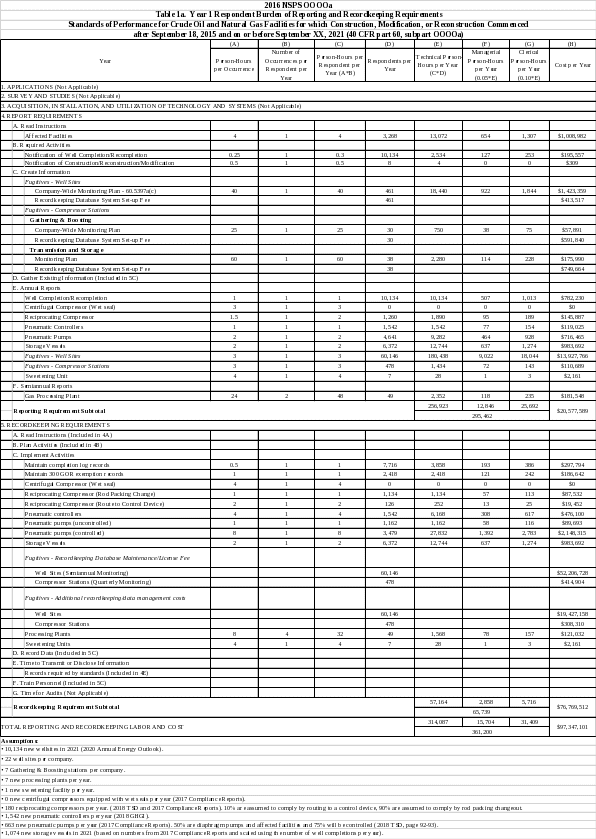



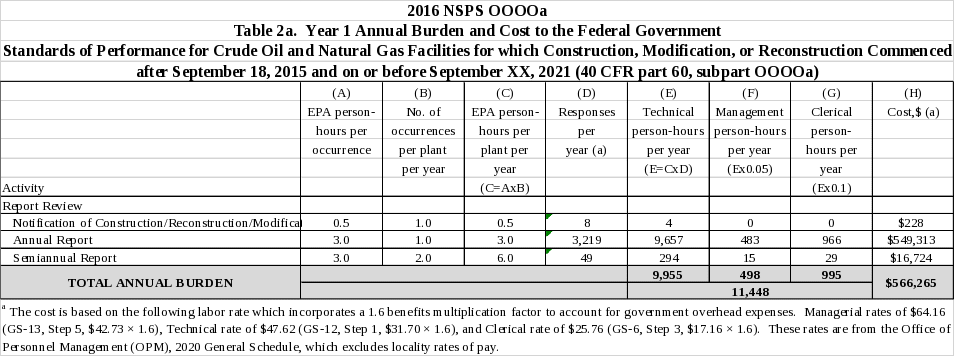
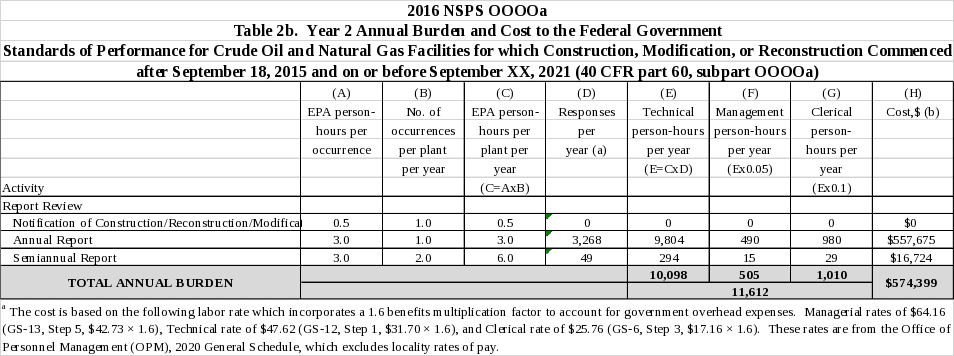
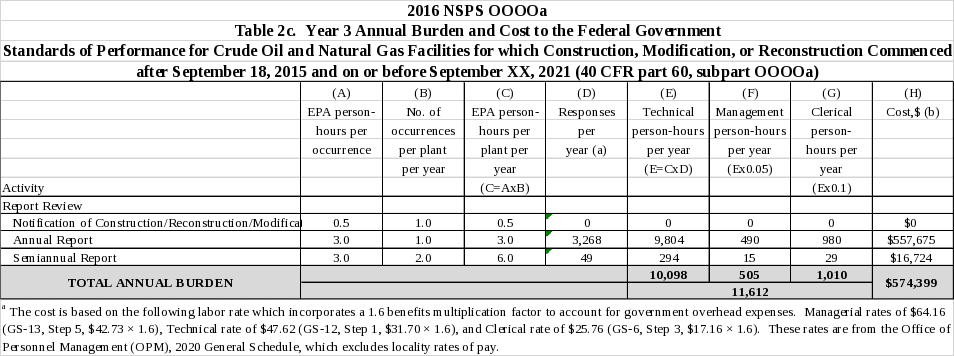

Appendix A
Estimate of New Sources Affected for purposes of the Information Collection Request under the Proposed Amendments to 40 CFR part 60, subpart OOOOa.
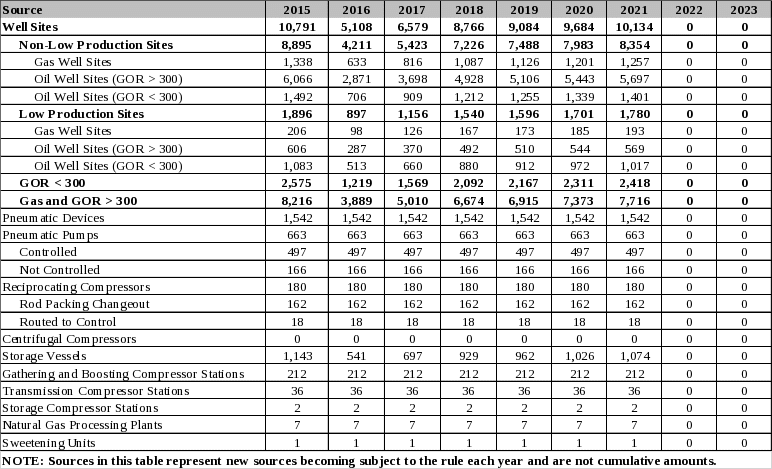 Appendix
B
Appendix
B
EPA’s Compliance and
Emissions Data Reporting (CEDRI) Interface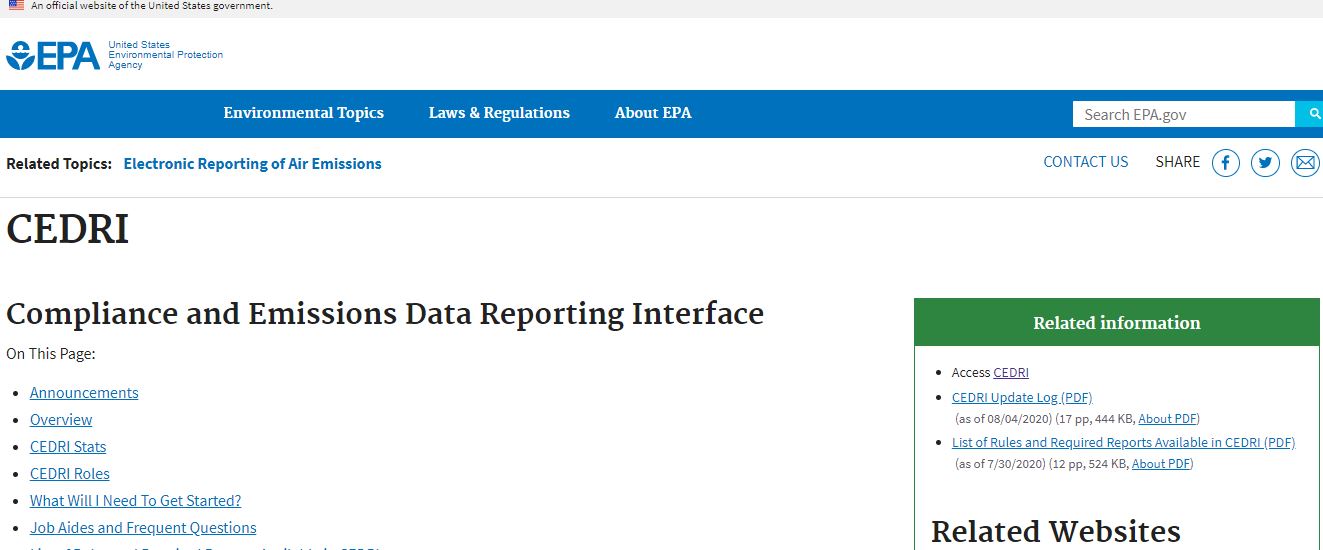
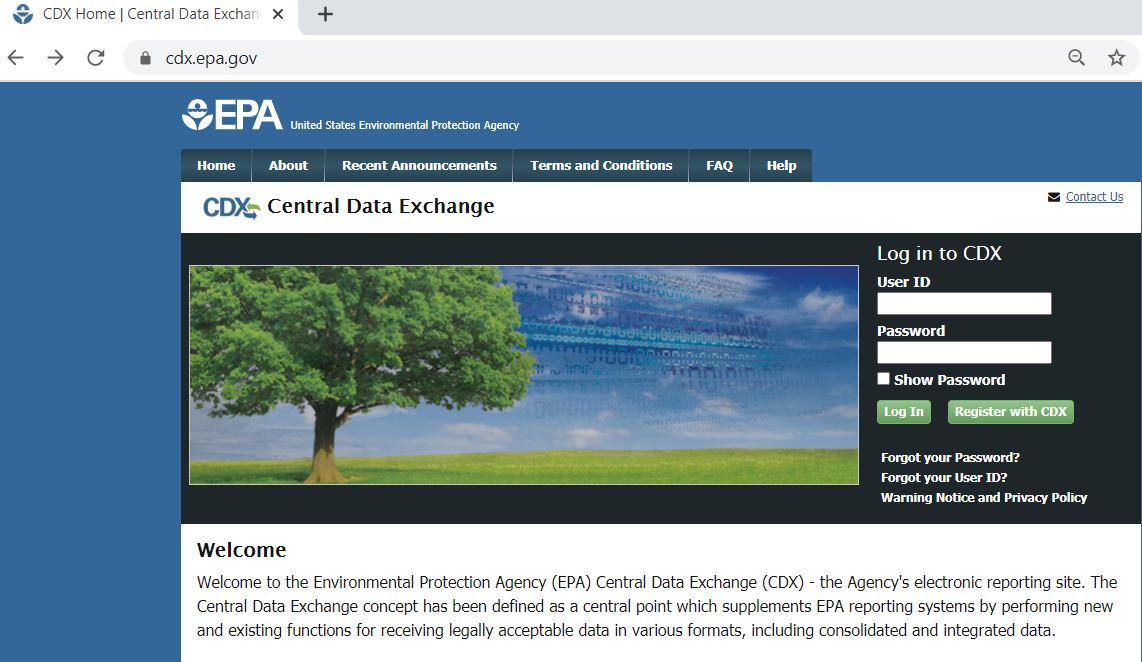
Appendix C
Instructions for submitting reports to the EPA via CEDRI per 60.5420a(c)(11):
(11) You must submit reports to the EPA via CEDRI, except as outlined below. (CEDRI can be accessed through the EPA's CDX (https://cdx.epa.gov/).) The EPA will make all the information submitted through CEDRI available to the public without further notice to you. Do not use CEDRI to submit information you claim as CBI. Anything submitted using CEDRI cannot later be claimed CBI. You must use the appropriate electronic report in CEDRI for this subpart or an alternate electronic file format consistent with the extensible markup language (XML) schema listed on the CEDRI website (https://www.epa.gov/electronic-reporting-air-emissions/cedri/). If the reporting form specific to this subpart is not available in CEDRI at the time that the report is due, you must submit the report to the Administrator at the appropriate address listed in §60.4. Once the form has been available in CEDRI for at least 90 calendar days, you must begin submitting all subsequent reports via CEDRI. The reports must be submitted by the deadlines specified in this subpart, regardless of the method in which the reports are submitted. Although we do not expect persons to assert a claim of CBI, if you wish to assert a CBI claim, submit a complete report generated using the appropriate form in CEDRI or an alternate electronic file consistent with the XML schema listed on the EPA’s CEDRI website, including information claimed to be CBI, on a compact disc, flash drive, or other commonly used electronic storage medium to the EPA. The electronic medium shall be clearly marked as CBI and mailed to U.S. EPA/OAQPS/CORE CBI Office, Attention: Group Leader, Fuels and Incineration Group, MD C404-02, 4930 Old Page Rd., Durham, NC 27703. The same file with the CBI omitted shall be submitted to the EPA via CEDRI. All CBI claims must be asserted at the time of submission. Furthermore, under CAA section 114(c), emissions data is not entitled to confidential treatment, and the EPA is required to make emissions data available to the public. Thus, emissions data will not be protected as CBI and will be made publicly available.
a For example, paragraph 60.5420a(a)(2)(ii) states that “If you are subject to state regulations that require advance notification of well completions and you have met those notification requirements, then you are considered to have met the advance notification requirements of paragraph (a)(2)(i) of this section.”
b The three-year projection does not include new sources for 2022 and 2023 since 40 CFR part 60, subpart OOOOb would be in effect for new sources for which construction, modification or reconstruction commenced after September XX, 2021. Existing facilities would in years 2022 and 2023 continue to be respondents due to ongoing reporting requirements.
c 85 FR 57018.
d 85 FR 57398.
| File Type | application/vnd.openxmlformats-officedocument.wordprocessingml.document |
| File Modified | 0000-00-00 |
| File Created | 2021-12-23 |
© 2025 OMB.report | Privacy Policy